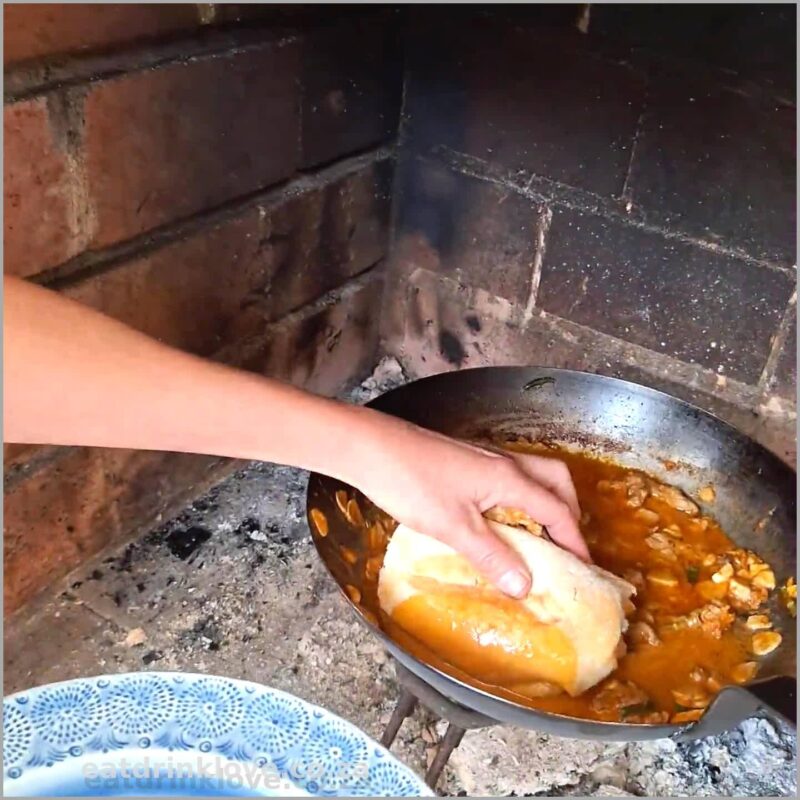The bifana is a beloved Portuguese street food, celebrated for its simplicity and bold flavors. This quintessential sandwich features thinly sliced pork marinated in a garlicky, wine-infused blend, seared to perfection, and tucked into a crusty roll. Often enjoyed at festivals, markets, or casual tascas, bifanas are a staple of Portuguese comfort food, with regional variations adding unique twists. This recipe delivers an authentic taste of Portugal, perfect for a lively gathering or a cozy meal paired with a cold beer or crisp vinho verde.
This recipe serves 4. I made this dish over an open fire, but off course it can be made on a stove.
Ingredients
- 500g pork (shoulder, loin, or neck), thinly sliced (2-3mm thick)
- 6 cloves garlic, thinly sliced
- 250ml dry white wine
- 3 Tbsp olive oil, divided
- 3 Tbsp white wine vinegar
- 1 Tbsp sweet paprika
- 3 bay leaves, finely shredded
- 1 tsp red pepper flakes (adjust to taste)
- 1 tsp sugar
- 1 Tbsp Massa de Pimentão (red pepper paste, optional for deeper flavour)
- 1 tsp salt or to taste
- ½ tsp black pepper, freshly ground
- 2 Tbsp lard (or substitute with olive oil)
- 4 crusty Portuguese rolls (papo seco or carcaça; substitute with ciabatta or baguette if unavailable)
- Optional: Yellow mustard, for serving (Vendas Novas style)
- Optional: Butter or olive oil, for toasting rolls
Instructions
Marinate the Pork: In a large bowl, combine garlic, white wine, 2 Tbsp olive oil, white wine vinegar, sweet paprika, shredded bay leaves, red pepper flakes, sugar, Massa de Pimentão (if using), salt, and black pepper. Mix well to create a marinade. Add the thinly sliced pork, ensuring all pieces are fully coated. Cover and refrigerate for at least 4 hours, preferably 12-24 hours, to allow the flavors to meld.
Cook the Pork: Remove the pork from the marinade, removing excess marinade, but reserving all reserving the liquid. In a large skillet, heat the lard (or 1 Tbsp olive oil) over medium-high heat. Working in batches to avoid overcrowding, sear the pork slices for 2-3 minutes per side until golden and just cooked through. Transfer to a plate and cover to keep warm.
Prepare the Sauce: Pour the reserved marinade into the skillet, scraping up any browned bits from the bottom. Simmer over medium heat for 3-5 minutes until slightly reduced and thickened. Adjust consistency with a splash of water or additional white wine if needed and then adjust the salt after that. Return the pork to the skillet, toss to coat in the sauce and cook for another 2-3 minutes.
Prepare the Rolls: Slice the rolls in half. For added texture, lightly toast the cut sides in a separate skillet with a small amount of butter or olive oil. For a regional twist (e.g., Conga style), dip the cut side of the top roll in the warm marinade sauce before assembling.
Assemble and Serve: Place 3-4 pork slices inside each roll, spooning a small amount of the reduced marinade over the meat for extra flavour. Serve hot, with optional yellow mustard on the side or spread on the roll (Vendas Novas style). Pair with fries, a green salad, or pickles, and enjoy with a cold Portuguese beer (Super Bock or Sagres) or a glass of vinho verde for an authentic experience.
Notes
Pork Cut: Pork shoulder is ideal for its tenderness and flavour, but pork neck (which I used here) or loin works well too. For easier slicing, partially freeze the pork for 3-4 hours to firm it up, then cut with a sharp knife. Pounding the slices to uniform thickness is optional but ensures even cooking.
Marinade Variations: Adjust red pepper flakes for desired heat. If lard is too rich, substitute with olive oil. Taste the marinade before adding the pork and adjust salt and pepper as needed.
Bread: Authentic bifanas use crusty Portuguese rolls like papo seco or carcaça. If unavailable, choose a roll with a crisp crust and soft interior, such as ciabatta or a baguette.
Regional Styles: For a Lisbon-style bifana, keep it simple with just pork and sauce. For Vendas Novas, add mustard and a touch more spice. In some regions, the roll is dipped in sauce (e.g., Conga in Porto), or the entire sandwich is soaked for a juicier bite.
History and Origin
The bifana traces its origins to Portugal’s Alentejo region, particularly Vendas Novas, where it is said to have been popularized in the mid-20th century. Local lore credits a café owner in Vendas Novas with creating the modern bifana, serving marinated pork sandwiches to travellers along the main road between Lisbon and the Algarve. The dish’s simplicity—pork, marinade, and bread—made it affordable and portable, cementing its status as a working-class favourite. Over time, regional styles emerged: Lisbon favours a straightforward preparation, while Vendas Novas often includes mustard and extra spice. In Porto and other areas, some dip the roll in the marinade for added flavour, as seen in establishments like Conga. Today, the bifana is a national icon, celebrated at festivals and tascas across Portugal, with each region adding its own flair to this humble yet delicious sandwich.



